钢铁侠制作图纸
Maya制作漫画英雄钢铁侠过程剖析
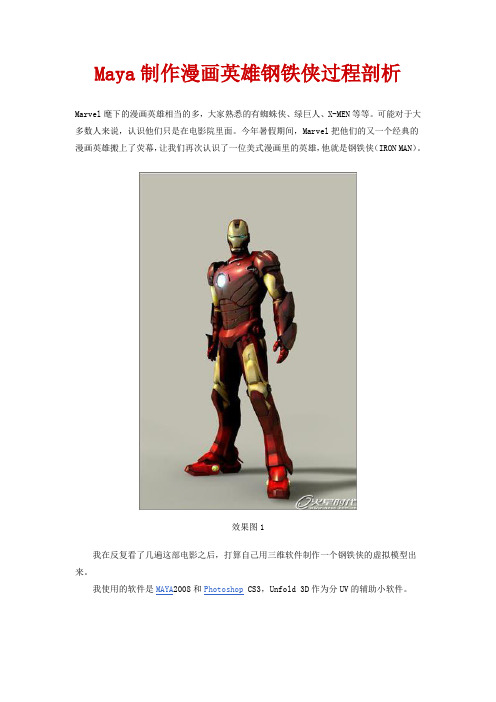
Maya制作漫画英雄钢铁侠过程剖析Marvel麾下的漫画英雄相当的多,大家熟悉的有蜘蛛侠、绿巨人、X-MEN等等。
可能对于大多数人来说,认识他们只是在电影院里面。
今年暑假期间,Marvel把他们的又一个经典的漫画英雄搬上了荧幕,让我们再次认识了一位美式漫画里的英雄,他就是钢铁侠(IRON MAN)。
效果图1我在反复看了几遍这部电影之后,打算自己用三维软件制作一个钢铁侠的虚拟模型出来。
我使用的软件是MAYA2008和Photoshop CS3,Unfold 3D作为分UV的辅助小软件。
效果图2制作这个模型之前,我通过网络查找了许多关于钢铁侠的图片作为参考,但都不是很理想,大家都知道,做三维角色或者其他的东西都需要正确角度的参考图,三视图是最理想的参考图了,在网络上我并没有找到关于钢铁侠的三视图,于是在没有三视图的情况下,我把头部制作了出来。
图1后来,我从朋友那里得来了一份钢铁侠的三视图,我非常感谢他,这是我目前见过最好的参考图了。
图2这个参考图有个小小的遗憾,上面没有手臂的侧视图。
图3我用的是MAYA的Polygon(多边形)建模方式。
这个是没有用三视图制作的头部模型。
大家可以从这个头部模型看到,其实这个头部并不是很复杂,它是由一个又一个的小的结构模型拼凑出来的,我在制作这个头部的时候也并没有花太多的时间,很快就把它制作出来了,因为每个小的结构模型的制作非常简单。
下面是我拆解开来的头部,大家可以看到它是如何构成的。
图4图5光滑代理后的头部模型从头部的制作思路来看,我准备把这个角色的每个部分,包括身、手臂、手掌、腿部都拆解开来分别制作,最后再总和在一起,完成这个模型。
图6这个是胸甲的模型部分。
胸甲这部分制作的难点在于我要在形准的情况下要保持步线的合理。
这里我用到最多的工具就是Edit Mesh里面的Split Polygon Tool工具,它是用来给模型添图7图中,红圈表示的地方我是用Edit Mesh里面Extrude(挤压)命令制作的,在用这个命令之前,我用Split Polygon Tool工具把我所需要的线勾画出来,形成一个可以让我挤压的区域,这里要注意的就是虽然我们把线勾画出来了,但是在模型上面就存在了很多奇怪的线。
超级钢技术路程图-简体

录
1 、超級鋼技術路程概述................................................................................错误!未定义书签。
超級鋼生產工藝流程圖 ....................ቤተ መጻሕፍቲ ባይዱ.............................................................................. 错误!未定义书签。 超級鋼生產技術路程圖 .................................................................................................................................. 5
3 、鐵水預處理............................................................................................... 错误!未定义书签。
3.1 鐵水預處理技術........................................................................................................ 错误!未定义书签。 3.2 歷史上六類十六種脫硫技術 .................................................................................... 错误!未定义书签。 3.3 鐵水脫硫技術............................................................................................................ 错误!未定义书签。 3.4 鐵水脫 Si 技術 .......................................................................................................... 错误!未定义书签。 3.5 铁水脱磷工艺技术.................................................................................................... 错误!未定义书签。 3.6 铁水预处理脱磷及同时脱磷脱硫 ............................................................................ 错误!未定义书签。 3.7 “一包到底”技術 ....................................................................................................... 错误!未定义书签。
3d打印调研报告
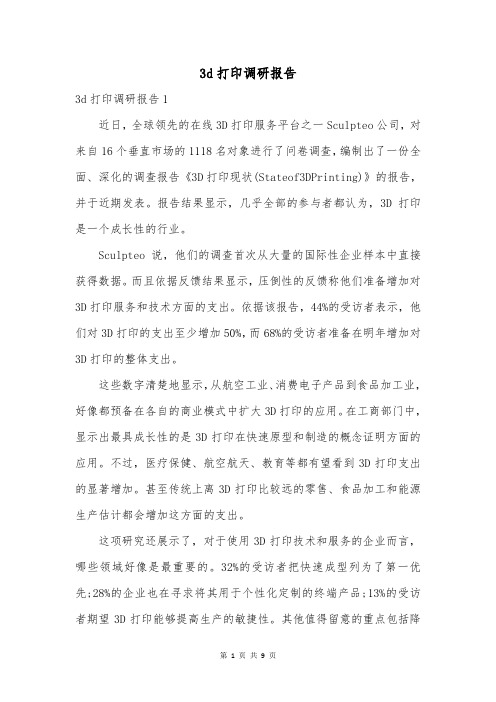
3d打印调研报告3d打印调研报告1近日,全球领先的在线3D打印服务平台之一Sculpteo公司,对来自16个垂直市场的1118名对象进行了问卷调查,编制出了一份全面、深化的调查报告《3D打印现状(Stateof3DPrinting)》的报告,并于近期发表。
报告结果显示,几乎全部的参与者都认为,3D打印是一个成长性的行业。
Sculpteo说,他们的调查首次从大量的国际性企业样本中直接获得数据。
而且依据反馈结果显示,压倒性的反馈称他们准备增加对3D打印服务和技术方面的支出。
依据该报告,44%的受访者表示,他们对3D打印的支出至少增加50%,而68%的受访者准备在明年增加对3D打印的整体支出。
这些数字清楚地显示,从航空工业、消费电子产品到食品加工业,好像都预备在各自的商业模式中扩大3D打印的应用。
在工商部门中,显示出最具成长性的是3D打印在快速原型和制造的概念证明方面的应用。
不过,医疗保健、航空航天、教育等都有望看到3D打印支出的显著增加。
甚至传统上离3D打印比较远的零售、食品加工和能源生产估计都会增加这方面的支出。
这项研究还展示了,对于使用3D打印技术和服务的企业而言,哪些领域好像是最重要的。
32%的受访者把快速成型列为了第一优先;28%的企业也在寻求将其用于个性化定制的终端产品;13%的受访者期望3D打印能够提高生产的敏捷性。
其他值得留意的重点包括降低模具投资(10%)、优化演示费用(10%)、改善备件管理(4%)等。
这份报告还显示,有19%的受访企业把增加可用的3D打印设备作为今后5年内的优先考虑事项,而只有13%的'受访企业把它列为今年的优先考虑事项。
16%的受访者认为今后5年内提高生产敏捷性重要,而6%的受访者更为看重备件管理。
接受调查的受访者中有53%称,材料和设备的价格是他们考虑使用或者接受增材制造和3D打印技术特别重要的因素。
同时在确定采用或扩大3D打印技术的应用范围时,高达60%的人认为3D打印机性能、稳定性和打印能力是特别重要的因素。
ARC-REACTOR反应堆
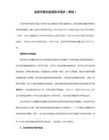
/question/155416022.html?fr=qrl&cid=96&index=3
/question/74813543.html?si=2
紧接着Tony就给他展示了第一代钢铁侠的设计图纸
不过话说回来,这电影太科幻了,他手上的激光炮要像发出那么大能量,瞬间需要的电量就连一个大型核电站也无法满足,而他的钢铁侠是用喷气式发动机,而要想突破音速,发动机就需要一个加力燃烧室,也就产生了飞机后面喷火的效果,而用加力燃烧室的话,必须要航空煤油,而一个钢铁侠体能的空间能装上从美国飞到阿富汗用的航空煤油根本不可能,所以这个电影很多不现实的地方。
推荐答案
核能。
钢铁侠利用冷核聚变。
现实还不能做到。现实只有热核聚变。冷核聚变技术还不成熟。
刚开始那个救他的Yinsen为了防止弹片进入他的心脏 所以做了个强磁铁
而这个强磁铁需要汽车电池来供电 而所谓的能量球(电影里是ARC-REACTOR 翻译过来是电弧反应堆)在做之前 托尼已经有了做钢铁侠逃出那里的想法 所以做了这么一个反应堆 一方面有电磁铁的功能 另一方面要用它做钢铁侠的供电装置
当时刚做好的
Tony :因为这是个小型电弧反应堆,我家那边有个大的,给工厂供电,这个可以给电磁铁供电,防止弹片进入心脏
Yinsen:它的发电能力怎么样?
钢铁侠战甲整理(包含大部分MK1-42)教材

MK1:是最原始的MK铠甲,功能不全面,而且动力系统只能维持大概50分钟,主要武器就是左手的喷火器,和右手的一发导弹,缺点是,很多关键的运作带,都外露,因此,受到枪击之后传送带易断了,断了之后腿不能动。
MK2:托尼逃脱之后回家研制的第一款盔甲,改良了动力系统,和飞行稳定系统,同时加固了外层钢甲。
缺点是材料不是很成熟,不能飞太高,《钢铁侠1》中勉强飞到8000米后结冰,然后失去动力。
这款装甲后来被托尼的好友吉姆.罗德斯带走,并且被美国军方改装成了新的装甲“战争机器”战争机器:上文提到过是MK2改造的,所以相对来说也不能飞太高,基本性能相当于MK2。
不过被美国军方改造之后增加了很多装备,如:加特林机枪,散弹枪,FN2000等(《钢铁侠2》中提到过)更显眼的是肩部汉默(《钢2》发明家,恨斯塔克)加上了“前妻”以汉默的话来说:“内含旋风炸药,可以炸毁一座碉堡以及碉堡地下的建筑”结果实战的时候。
毛用也没有啊!掉水里了直接灭了啊!不过在大战机器士兵时候那些机枪还是很管用的,在《钢铁侠3序曲漫画》中提到过,这套盔甲被托尼回收了,之后给了罗德斯一套新的盔甲(也就是《钢铁侠3》中美国国旗颜色的盔甲)MK3:托尼改良了盔甲所使用的材料,外层采用军事卫星所用的金钛合金,重量减轻了,还不会结冰,而且强化了一些武器比如手臂部的反坦克导弹,以及肩膀上的霰弹枪,至于红金配色的想法,是来自于托尼收藏的一辆汽车,金红相间。
MK4:它在MK3的基础上完全改进了外形,改的更加贴合人体流线型,且是MK6的跳板,在武器设定上大体与MK3相当,因为改进了外形,所以减轻了重量,因此飞行速度对于MK3来说有一定的提升。
MK5:这是托尼特别制作的便携式钢铁侠盔甲,平时只是一个箱子,激活箱子之后,可以覆盖全身变成钢铁侠盔甲,这个盔甲的缺点就是,只有一层护甲,很薄,但是带在身边很方便可以便装出行,必要时刻激活箱子变身钢铁侠,大体上说弱了很多,武器只有掌心炮,盔甲虽然弱,不过确实是很方便。
钢铁侠连杆制作钢铁侠开合器资料

舵机安装方法:标配都是一对14CM塑料条和两个金属轴,和一条木片,一对舵机!舵机内部结构已经改变,两个舵机都成镜像转动,便于左右对称安装!两个舵机底座相连,用热熔胶或者塑料胶粘在一起,侧面也粘在一起,一定要整齐,保证两个转轴在同一中心轴上,热熔胶粘在一起有个缺点,要是舵机工作量时间过长会发热,热熔胶会化掉,用热熔胶也行,打开时间不要太久!插上板子接上电源,板子进入初始化,不要让舵机转动,两个舵机一直保持自锁在0度的归位状态。
这时候对照两个白色旋转臂是否在同一个角度位置,如果不在同一角度,白色旋转臂拔下来再对照好插上去!使得舵机的两个杆满足以上需求!保障转动的时候,两个可以一同平行转动,这样不会折坏拉杆。
下来截取连杆的长度计算!因为每个人的头盔大小都不一样,所以说连杆长度计算不了!只能在安装的位置自己量取,大概在什么位置呢,如图片所示连杆的长度该如何选取,舵机连好之后放在凸出的地方等量一下,以舵机转轴中心为起点,到眼睛上部一厘米左右的距离为准,就是连杆的长度,大概量出距离是5-8CM之内吧,很多头围大小不一样,这个只能自己量。
然后按两个对称的连杆截取长度,使得转轴孔要对应平行,对准!截取后黄色的连杆和白色的联轴器要紧紧地固定在一起,而且要平行角度一致!把截取剩下的连杆,找到对应的孔,裁割一小段,作为,连接转轴端子,套在转轴上。
然后把联轴端子和轴条插到刚才的,连杆孔里,长的联轴器最好用上面最小的孔,那样锁的死,不会脱落!而前段两个翘起来的连接转轴端子用中等的轴孔,这样转动方便!做好后的实物图!然后进入到下一步!侧面图,在舵机归零位的时候,把转动端子,小的那个粘在面罩上面,把舵机粘在头盔凸出的地方,安装的时候一定要注意,必须要在,电路板上电工作,舵机锁死的情况下,初始化不操作,才是归零位,把归零位的状态安装在面罩开合的那里!也一定要注意,当舵机转动的时候一定要向上转动,不要按反了舵机!确保舵机状态为归零位的状态按上去,那么下次关闭的时候也就达到了这个状态!舵机底板先用胶轻微固定在凸出板上,试着控制舵机转动,看看是否向上转动,然后敢感觉安装得正,不要偏了,再用胶枪粘牢固。
泰坦尼克号简易纸模型图纸二
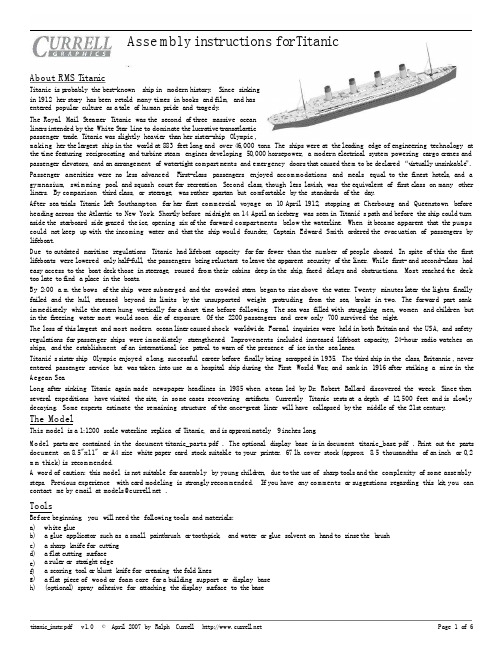
Asse m bly inst ruct ions forT i tan icAbout R MS T i tan i cTi tanic i s p robably the bes t-known sh ip in modern hi s tory. S ince s ink ingin 1912 her s to ry has been re to ld many t imes in books and f i lm, and hasente red popula r cul tu re a s a t a le o f human pr ide and t r agedy.The Royal Mai l S teamer T i tan ic was the second o f th ree mass ive oceanl ine rs in tended by the White S ta r L ine to domina te the lucra t ive t ransa t lan t icpassenger t r ade. T i tan ic was s l ight ly heav ie r than her s i s te r-ship Olympic,making he r the la rges t sh ip in the wor ld a t 883f ee t long and over 46,000tons. The sh ips were a t the lead ing edge of engineer ing t echnology a t the t ime fea tur ing rec ip roca t ing and tu rbine s t eam engines develop ing 50,000 horsepower,a modern e lec t r i ca l sys tem power ing cargo c ra nes and passenger e l eva tors,and an ar rangement o f wate r t igh t compar tments and emergency doors tha t caused them to be dec la red“v i r tua l ly uns inkable”. Passenger ameni t i es were no l es s advanced. F i r s t-c la ss passengers enjoyed accom modat ions and mea ls equa l to the f ines t ho te l s,and a gymnasium,swim ming poo l and squash cour t fo r r ec rea t ion. Second c las s,though le ss lav ish, was the equiva len t o f f i r s t c l ass on many o ther l ine rs. By compar ison th i rd c l ass, o r s t ee rage, was ra ther spar t an but comfor tab le by the s tandards o f the day.After sea t r ia l s T i tan ic l e f t Southampton fo r he r f i r s t com merc ia l voyage on 10 Apri l 1912,s topping a t Cherbourg and Queens town be fore head ing across the At lant i c to New York. Shor t ly before midn igh t on 14 Apr i l an iceberg was seen in T i tanic’s pa th and before the sh ip could turn as ide the s ta rboard s ide g razed the ice, opening s ix o f the fo rward compartments be low the water l ine. When i t became apparen t tha t th e pumps could no t keep up wi th the incoming wa ter and tha t the sh ip would founder, Capta in Edward Smith o rdered the evacuat ion o f passengers by l i f eboat.Due to outda ted mar i t ime r egula t ions T i tan ic had l i feboa t capac i ty fo r fa r f ewer than the number o f people aboard.In sp i te o f th i s the f i r s t l i f eboat s were lowered only ha l f-ful l,the passengers be ing re luctan t to l eave the apparen t secur i ty o f the l iner. While f i r s t- and second-c l ass had easy access to the boat deck those in s t eerage,roused f rom thei r cabins deep in the sh ip,f aced de lays and obs t ruct ions. Most r eached t he deck too la te to f ind a p l ace in the boat s.By 2:00 a.m.the bows o f the ship were submerged and the c rowded s t e rn began to r i se above the wa ter. Twenty minutes l a te r the l ight s f ina l ly fa i l ed and the hul l,s t r essed beyond i t s l imi ts by the unsuppor ted weigh t p ro t ruding f rom the sea, b roke in two. The fo rward par t sank im media te ly whi le the s te rn hung ve r t i ca l ly fo r a shor t t ime before fo l lowing. The sea was f i l l ed with s t rugg l ing men, women and ch i l dren but in the f r eez ing wate r mos t would soon d ie o f exposure. Of the 2200 passenger s and c rew on ly 700 survived the n igh t.The loss o f th i s l a rges t and most modern ocean l ine r caused shock wor ldwide. Formal inqu i r ies were he ld in both Br i ta in and the USA, and sa fe ty regula t ions fo r passenger sh ips were im media te ly s t r eng thened.Improvements inc luded inc reased l i f eboat capac i ty, 24-hour r adio wat ches on sh ips,and the es t abl i shment o f an in te rnat ional i ce pa t ro l to warn of the presence o f i ce in the sea lanes.Ti tanic’s s i s t e r sh ip Olympic en joyed a long,success ful ca reer be fore f ina l ly be ing sc rapped in 1935. The th i rd sh ip in the c l ass, Br i tanni c, never ente red passenger se rv ice bu t was t aken in to use a s a hospi t a l sh ip dur ing the F i r s t Wor ld War,and sank in 1916 a f te r s t r ik ing a mine in the Aegean Sea.Long af t e r s inking T i tan ic again made newspaper head l ines in 1985 when a team led by Dr. Rober t Ba l la rd d i scovered the wreck. S i nce then severa l exped i t ions have v is i t ed the s i t e,in some cases recover ing a r t i f ac t s. Cur ren t ly T i tan ic r es t s a t a dep th o f 12,500fee t and i s s lowly decay ing. Some exper t s e s t imate the r emaining s t ruc tu re o f the once-grea t l ine r wi l l have co l lapsed by the middle o f the 21s t century.The ModelThis model i s a 1:1200sca le wa ter l ine r ep l ica o f T i tan ic, and i s approx imate ly 9inches long.M odel par t s a re con ta ined in the document t i tanic_parts.pdf. The op t iona l d i splay base i s in document t i tan ic_base.pdf. P r in t ou t t he par t s document on 8.5"x11" o r A4 s i ze whi t e paper card s tock su i tab le to your p r in te r. 67lb.cover s tock(approx. 8.5thousand ths o f an inch o r 0,2 m m th ick)i s r ecom mended.A word of cau t ion:th i s model i s not su i t able fo r assembly by young chi ld ren, due to the use of sharp too ls and the complexi ty o f some assembly s teps. Prev ious exper i ence wi th ca rd model ing i s s t rongly recom mended.I f you have any com ments o r sugges t ions regard ing th i s k i t,you can contac t me by emai l a t model s@curre l l.ne t.Too lsBefore beg inning, you wi l l need the fo l lowing too ls and mater ia l s:a) b) c) d) e) f)whi te g luea glue appl i ca tor such as a smal l pa in tbrush o r toothp ick, and wate r o r g lue so lvent on hand to r inse theb rush a sharp kni fe fo r cut t inga f la t cu t t ing su r facea rule r o r s t r a igh t edgea scor ing too l o rb lun t kn i fe forc reas ing the fo ld l inesa f la t p iece of wood or foam core fo r a bu i ld ing suppor t o r d i sp lay base(op t iona l)spray adhes ive fo r a t tach ing the d i sp lay su r face to the baseg)h)t i t an i c_i n s t r.pd f v1.0© Apr i l2007by Ra lph Cur r e l l h t tp://ww w.cur r e l l.ne t Page1o f6Hintsa) b) c) d) e)Selec t a we l l -l i t , comfor tab le work a rea tha t wi l l r emain und is tu rbed when you a re not the re . Keep your hands and too ls c lean when work ing , to avo id ge t t ing g lue on vi s ib le par t s o f the model . I t ’s ea s ie r to s tay organ ized i f you only cu t out those par t s you need for each s tep . M ake sure your kni fe i s sharp . When cu t t ing s t r a igh t l ines , u se a s t r a igh t -edge . Study the d iagrams ca refu l ly , and a lways te s t -f i t the pa r t s before apply ing g lue .Asse m blyPortAft (Stern)Forward(Bow)StarboardIn these ins t ruc t ions , the t e rms fo rward (bow) and a f t (s t e rn) r e fer to the f ron t and rear ends of the ship . Por t and s t a rboard r e fe r to the le f t and r ight s ides . Scor ing o f pa r t s i s ind ica ted by th in b lack l ines ou ts ide the pa r t ’s ou t l ine , and by dashed or shaded l ines on the par t ’s su r face . For smal l pa r t s such as the deckhouses and c ranes i t i s r ecom mended tha t ou ts ide corners (‘mounta in ’ fo lds ) a re scored b y gen t ly scr ib ing t he score l ine wi th a kn i fe re sul t ing in a sharp corner when fo lded . Score par t s be fore cu t t ing them out . In the d iagrams , subassembl ies a re ident i f i ed by a number wi th in a c i rc le (e .g . ), cor responding to the s tep in which i t was assembled . Step 1: Lamina te the la t e ra l fo rmers to heavy ca rd s tock , such tha t the combined th i ckness i s abou t 1m m or 0.04 inches . Cut ou t the formers af te r lamina t ing . Assemble the l eng thwise fo rmer (s tep 2) t aking ca re to on ly g lue the cent ra l (b lue shaded) a rea and a l lowing the f l a ps a t the bot tom to fo ld ou tward . Cu t the upper p rof i l e a f t e r g lu ing and fold as shown in the d iagrams . Assemble the in t e rna l s t ruc ture by g l uing the la t e ra l fo rmers in to s lo t s in the leng thwise fo rmer (s tep 3). Some p ieces must be o r ien ted such tha t the p r in ted s ide f aces a f t ; these a re l abe l led as such . At tach the we l l deck s t i f feners (s tep 4) in to the appropr ia t e s lo t s . At th i s s tage the model should be a t t ached to e i ther a temporary work base (s tep 5) o r to the opt ional d i sp lay base (s tep 6). Th is p revent s the f rame f rom warping dur ing subsequen t s teps . I f us ing a t emporary base , app ly on ly a smal l amount o f g lue so the sh ip may be la t e r d etached eas i ly . At tach the fo recas t l e and poop decks to the f r ame (s tep 7). The fo rward t ip o f the fo recas t l e wi l l p ro t rude s l ight ly beyond the f ron t o f the f rame.The shap ing and a t tach ing o f the hu l l su r faces a re some what cha l leng ing . Dry-f i t t ing and ca refu l a t t ent ion to the d rawings wi l l he lp . At t ach the connec t ing s t r ips to the main and s t e rn sec t ions o f the s t a rboard hul l sur face (s tep 8). To avo id gaps , bend the par t s as c lose ly as poss ib le to match the contour o f the f rame before g lu ing the s te rn sec t ion to the main sec t ion . Repea t for the por t hul l pa r t s and g lue por t and s t arboard toge ther a t the rudder on ly (s tep 9). S l ide the hul l p ieces a round the f rame f rom the s t e rn , such tha t the rudder i s pos i t ioned undernea th t he s te rn overhang (s tep 10). The rear edge of the hu l l p l a t ing shou ld a l ign wi th the cen t re o f the r earmost la t e ra l fo rmer . Beginn ing a t the s t ern and working fo rward , g lue the hul l sur face to the f r ame. The wel l deck cu tout s on the top o f the hu l l should match the fo re and a f t bulkheads o f the well decks . F inal ly , jo in the por t and s t a rboard su r faces where they meet a t the bow. Form the coun te r p la t ing in to shape (s tep 11) and a t t ach over the s t e rn f ramework . I f you a re us ing a temporary work base , the sh ip may be de tached now. Fold and a t tach the decks and bulkheads jus t beh ind the fo rward we l l deck (s tep 12) and in f ront o f the a f t wel l deck (s tep 13). The a f t promenade deck B48 has a somewhat complex shape and requi res p rec i se scor ing and ca re ful fo ld ing . At tach the boat deck (s tep 14) so tha t the top of the longi tud ina l fo rmers p rot rude th rough the ho les in the deck . Steps 15 through 20 show the as sembly o f the va r ious deckhouses to the boat deck , beg inn ing a f t and work ing fo rward . Severa l o f these requi re care fu l fo ld ing , so c lose a t ten t ion to the d rawings i s recom mended. Blue loca t ing marks a re pr in ted on the boa t deck indica t ing the pos i t ion o f the deckhouses .Bend the wheelhouse bu lwark B14 to shape (s tep 21) and a t t ach to the f ront o f the boa t deck , add ing the wing roofs B13. Bu i ld and a t tach the off ice rs quar te r s and whee lhouse to the boa t deck (s tep 22) such tha t the f ron t o f the wheelhouse abu ts the f ron t f ace of the bu lwark added in the p rev ious s t ep . I t may be necessa ry to t r im s l igh t ly the rea r edge o f pa r t B51 to ach ieve a snug f i t aga inst the deckhouse a f t . At t ach the promenade deck s ides (s tep 23), wi th the r a i sed bulwarks p rot rud ing above the boa t deck and the f ron t edge nes t ed beneath the br id ge wing overhangs a s shown in the d iagram. A typ ica l e l ec t r ic c rane as sembly i s shown in s tep 24. At t ach the c ranes and cargo ha tches as shown in the d iagram (s tep 25). Fold and a t t ach the dock ing b r idge to the s t e rn (s tep 26). The forward ca rgo ha tch , b reakwater and anchor c rane a re added in s tep 27. Step 28 shows a typica l funne l a ssembly . Note tha t the funnel s a re no t iden t ica l in s ize . A l e t t e r i s p r in ted on the connec t ing s t r ip , cor responding with the le t te r a t the funnel ’s loca t ion on the deckhouse roof . Also , the funne l cap for the a f t funne l i s d i f fe r en t f rom the o ther th ree f unnel s . Attach the funne ls (s tep 29) wi th the seam fac ing the s t e rn , so tha t the funne ls s lope af t s l ight ly . Build and a t t ach the compass p l a t form (s tep 30). For g rea ter r ea l i sm you may rep lace the bo t tom suppor t B42 with four l egs made f rom wire . A t emplate fo r shap ing the two mast s i s shown on the par t s shee t . Too thp icks whi t t l ed o r sanded to s i ze , o r s t re t ched p l as t i c sprue , a re recom mended fo r these par t s . Bu i ld and a t t ach the c row ’s nes t and inse r t the mast s in to the ho les in the deck (s tep 31). The base of th e mas ts shou ld res t in no tches cu t in to the in t e rna l fo rmer . I f des i r ed , shrouds (suppor t ing cab les fo r the mast s ) can be made f rom f ine wi re o r ny l on l ine . Attach the upper ends o f the shrouds to the mast and the lower ends to the ou ter edge o f the we l l deck . Const ruct the l i f eboa ts as shown (s tep 32). There a re th ree s izes o f l i feboa t , a t tached to the upper decks as indica ted in the d iagram.t i t an i c_i n s t r .pd f v1.0 © Apr i l 2007 by Ra lph Cur r e l l h t tp ://ww w.cur r e l l .ne t Page 2 o f 61La minate la tera l formers toheavycardstock2LengthwiseformerA20Glueonly inarea ind icatedbyblueshading(o ther areaswi l l fo ldou tward).C ut formerlayout f ro mpartssheet 'A '. C o m binedth icknessshouldbe approx imate ly1m m or0.04inches.C utupperpro f i leands lotsa f terglu ing.ABCNOPDEFGHIJKLMAft ForwardBo w a ndsternf lapsfo ldouthor izontal l y . C entref laps fo ld outwardasshown.3Latera l formers4W el ldeck st i f feners5O pt ional temporarybase(So me partso mit ted forc lar i ty .) A17facesfwdE Tokeepthef ra mefro m w arp ingat tachtoaf la tp ieceofwood orplast ic .Useon lyas mal l a m ou ntofg luesothe basecanbelater A5A4 af tdetached.Bo wfwdA3A2 A18DA1Su ggestedglu ingpoints indicatedby 'x '.CC2af tA BAaf tAt tachre main ingformersA6-A16 in thesa me m ann er .Stern6O pt ionald isp laybase7Forecast leandpoopdeckO p enholeformast .Thebasesurface is inf i le t i tan ic_base.pd f .At tachtoaf la tp ieceofwood, plast i cor foa mcore.Bo wB62Stern8Starboardhul lsur faceA19(inkeds idefac ingdo wn)9Joinportandstarboardhul lsur faces A21,26-28Asse m bleas mir ror A23+A24(inkeds idefac ingdo wn)imageofs tarboardhu l l .A23A24A25U pperf lapbendsoutwardtowards ternToped gel inesupwi thb lack/whi te de m arkat iononhul l .Glueatrudderon ly .R e m aindero fhu l lspreadsto cover fra me.Be ndsur faceparts tom atchf ra mesha peatstern.8t i t an i c_i n s t r .pd f v1.0 © Apr i l 2007 by Ra lph Cur r e l l h t tp ://ww w.cur r e l l .ne tPage 3 o f 610 Attachhul lsur facetof rameopenslotaf tW el ldeckcu tou tshoulda l ignwi th foreandaf tbu lkheadsof thewel ldeck.Be ging lu ingat thesternand work forward.Al ignrearedgeofhu l lp la tewi ththecent reof therearmost la tera l former.Joinhul lp la teswheretheym eetatbow.Posit ionrudderunderoverhangingcounter.Stern Bo w11 Counter 12 Forwardbr idgeandpromenadedecksA22B12B1113 Aftbr idgeandpromenadedecks B48Scoreandfo ldasshown.(Unders idev iew)Foldf laps tocrea tewal lsB58O p enholeformast.14 Boatdeck 15 SecondclassentranceB38 B15 B36 B35B37B39Foldtodoubleth icknessandcuttoshape16 S m okeroo mandfunneldeckhouse 17 Tankroo mandskyl ightsB50 B41dB40B40 FwdopenslotB49B34(Unders ide)Foldf lapsassho wntocreatewal lst i t an i c_i n s t r.pd f v1.0© Apr i l2007by Ra lph Cur r e l l h t tp://ww w.cur r e l l.ne t Page4o f618 No.3funneldeckhouse19 LoungeroofB76Foldtodoubleth ickness andcuttoshapeFwdccB80Scoreand fo ldasshown.B79(inkeds ideshow nfac ingdo wn) Scoreand fo ldasshownB7720 No.2funneldeckhouseandskyl ight21 W heelhousebulwarksB65 B14Scoreandshapeassho wnB67 Frontands idesofB14at tachtoedgeofboatdeckasshow n.B68bB13B66B64(inkeds ideshow nfac ingdo wn) Scoreand fo ldasshown22 Off icers 'quar tersand wheelhouse23 Pro m enadesidesB60B52Foldtodoubleth ickness andcuttoshapeB17aB61Theseed gesare f lushwiththetopof theboatdeck .B51B16Tr imrearedge i fnecessaryto achieveasnugf i t .24 Elect r iccranes25 Locat ionofcranesandcargohatchesB74B59+B72 B63+B70B59+B28H atchesB6,7,8,9,10 Foldtot r ip le th ickness andcuttoshape.24B10 B9 B8B7 B6At tachtoblue locat ing marks ondeck.B59(inkeds ideshow n facingdown)B59+B75B59+B73 B63+B71 B59+B29t i t an i c_i n s t r .pd f v1.0 © Apr i l 2007 by Ra lph Cur r e l l h t tp ://ww w.cur r e l l .ne tPage 5 o f 626 Dockingbr idge 27 Forecast ledeta i ls28 No.1funnelB2aaB78Scoreand fo ldasshown.B20B21Inkedsur face B3B4B19Lineup wi th funne lsea mB46B18sho wnfacingdownB5B18,B19and B 46fo ld todouble th ickness andcuttoshapeAt tachto locat ing m arksondeck.At tachtoblue locat ing marks ondeck.funne l sea m29 AttachfunnelsB22-25,B46Funnelsea ms faceaf t2830 Co mpasspla t formB26,27,30,31,46O pt ional ly ,rep laceB42with suppor t legs mad efrom wire.B43 B42B32,33,44,45,47N o.4funne lcapAt tachto loungeroo fbe tween funne ls3and4.sea mLetterpr in tedonfunne lconnect ingst r ip correspondsto let terondeckhouseroof .31 M astsandcrow'snestCreate mastsus ingtoothp icksorst retchedInser tmasts in toholes indeck plast i csprueus ingthete mplateonthepar ts sheet fors ize.Mastsareround incross- sect ionandco loureddarkbrown. (baseofmastrests innotch in in ternal former).Mastss lopeto reara tsa mea ngleasfunne ls (approx .9°f romver t ica l). Shrouds(i fused)maybe m ade f ro mf inewireorny lonl ine.At tachlowerendsofshroudsto outeredgeofwel ldeck .B53O pt ionalshrouds (suppor tcab les)Bo wSternD eckleve laf tforward32 Li feboatsB81 B54+B5525ftcut terontopofco l laps ible27ftcol laps ib le30ft l i feboat27foot col laps ib le l i feboat(4boats)69B56+B5730foot l i feboat (14boats)25footcu t ter (2boats)t i t an i c_i n s t r .pd f v1.0 © Apr i l 2007 by Ra lph Cur r e l l h t tp ://ww w.cur r e l l .ne t Page 6 o f 6。
钢铁侠的拼搭方法

钢铁侠的拼搭方法
1.套装组装:钢铁侠通常会根据不同的任务和需求选择不同
的套装进行组装。
他会根据需要选择适合的盔甲、手套、胸甲、腿部装甲等组件,然后将它们组装在一起以形成一个完整的战
斗装备。
2.个人定制:为了满足他独特的要求和个人风格,钢铁侠会
进行个人定制的拼搭。
他会使用先进的科技和工具,如3D打
印技术等,来设计和制造各种组件,并将它们与现有的套装部
件进行组合。
这些个人定制的组件可以是更强大、更灵活、更
具创意的,以适应各种不同的战斗场景和敌人。
3.组件升级:随着科技的不断进步和战斗的不断挑战,钢铁
侠会不断升级他的装备。
他会根据战斗中的实际需求,对现有
的组件进行改进和升级,以提高性能和功能。
这可能包括增加
更先进的武器系统、增强防御能力、提升动力和飞行能力等。
4.团队配合:除了个人定制和升级,钢铁侠还会与其他超级
英雄和科学家合作,以获得更多资源和专业知识。
他会与其他
科学家共同研究和开发新的技术和设备,为他的装备提供更多
创新的组件和功能。
钢铁侠
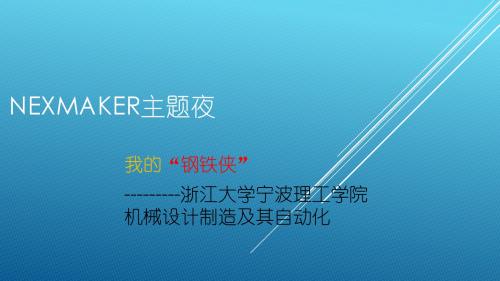
2011的时候,也看到了一个做动漫的道具师 (网名叮当)。制作了自动化的MK4
根据叮当的消息,找到了钢铁侠的爱好者组织, 铁人吧,并且加入了其中,每天一有空就在里 面晃荡,学习如何制作钢铁侠, 之后,在大二的开学的时候,制作了属于的钢 铁侠第四代方舟反应炉(模型)
开始自己用cad进行绘制
开始找加工单位进行加工
NEXMAKER主题夜
我的“钢铁侠”
---------浙江大学宁波理工学院 机械设计制造及其自动化
2009的年闻
/ARTICLE/4 2681/
对于钢铁侠的热爱是他去完成了钢铁侠MK3
这是他制作的铠甲勇士炎龙侠
差不多这时候已经快开学了, 然后就没有开始了,开学后分 院没有也没有找到可以提供制 作的地方,知道9.24在信息专 业这边找到实验室才开始继续
制作软连接
可动性考虑
喷漆实验开始。。。
回来之后就开始快要考试,然后准备复习什么的,没有 开始,知道7.11放假,室友全部回家之后开始开工..
这是护手..
先做一个大的支架!
胸甲和背甲(第一次失败品)
加强型改进版背甲
小臂
腹甲
前后效果的对比,后面一个更有层次感。
穿戴实验
3D 打印手指
头盔实验,,算了,这个东西真心做不 好。。。
点灯!
发现不是很好之后,在网上看见一个很不错的,就买了一个回来继续实验
做完灯之后,开始学习制作整一个大的盔甲
首先是选材,够了一大卷的EVA材料, (差不多是25个平方,怕不够买多了)
开始试验第一个头盔(自己做的烂的拿不 出手,这是朋友做的借鉴一下)
头盔做了一个就感觉不行,就搁置着,差不多 这时候到了五月份,有一个一直联系的网友是 在杭州,然后乘着五一就赶过去他家了。。
3d打印实习报告
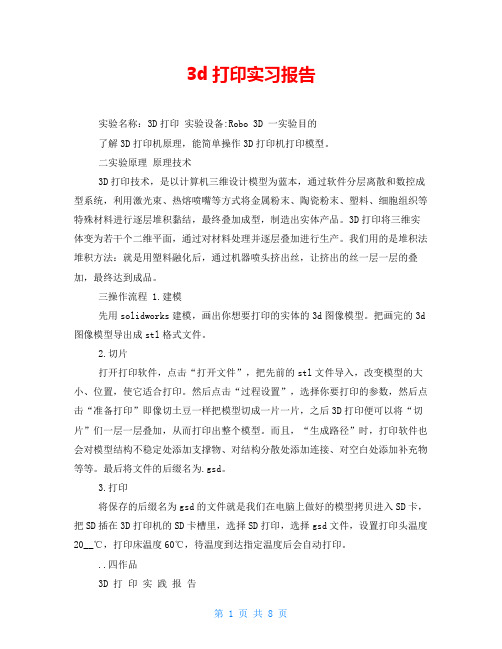
3d打印实习报告实验名称:3D打印实验设备:Robo 3D 一实验目的了解3D打印机原理,能简单操作3D打印机打印模型。
二实验原理原理技术3D打印技术,是以计算机三维设计模型为蓝本,通过软件分层离散和数控成型系统,利用激光束、热熔喷嘴等方式将金属粉末、陶瓷粉末、塑料、细胞组织等特殊材料进行逐层堆积黏结,最终叠加成型,制造出实体产品。
3D打印将三维实体变为若干个二维平面,通过对材料处理并逐层叠加进行生产。
我们用的是堆积法堆积方法:就是用塑料融化后,通过机器喷头挤出丝,让挤出的丝一层一层的叠加,最终达到成品。
三操作流程 1.建模先用solidworks建模,画出你想要打印的实体的3d图像模型。
把画完的3d 图像模型导出成stl格式文件。
2.切片打开打印软件,点击“打开文件”,把先前的stl文件导入,改变模型的大小、位置,使它适合打印。
然后点击“过程设置”,选择你要打印的参数,然后点击“准备打印”即像切土豆一样把模型切成一片一片,之后3D打印便可以将“切片”们一层一层叠加,从而打印出整个模型。
而且,“生成路径”时,打印软件也会对模型结构不稳定处添加支撑物、对结构分散处添加连接、对空白处添加补充物等等。
最后将文件的后缀名为.gsd。
3.打印将保存的后缀名为gsd的文件就是我们在电脑上做好的模型拷贝进入SD卡,把SD插在3D打印机的SD卡槽里,选择SD打印,选择gsd文件,设置打印头温度20__℃,打印床温度60℃,待温度到达指定温度后会自动打印。
..四作品3D 打印实践报告班级:工设一班学号:311317040124 姓名:胡明亮3d打印结课总结本学期我们在刘建学老师的带领下初步接触了3d打印技术。
经过一个下午的打印实习我成功的打印出了我的第一个作品—一把小梳子,梳子纹理清晰,造型与普通产品差别并不大。
这让我体会到了3d打印的神奇也激发了我学习3d打印技术的兴趣。
我在网络上查阅到3D打印是快速成型技术的一种,它是一种以数字模型文件为基础,运用粉末状金属或塑料等可粘合材料,通过逐层打印的方式来构造物体的技术。
泰坦尼克号简易纸模型图纸二
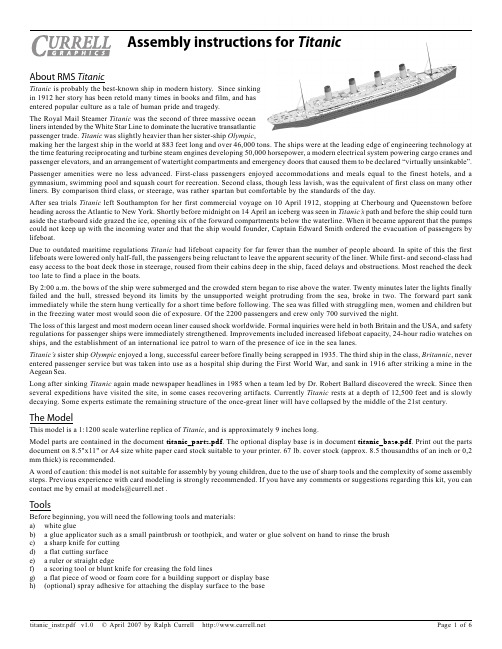
Assembly instructions for TitanicAbout RMS TitanicTitanic is probably the best-known ship in modern history. Since sinkingin 1912 her story has been retold many times in books and film, and hasentered popular culture as a tale of human pride and tragedy.The Royal Mail Steamer Titanic was the second of three massive oceanliners intended by the White Star Line to dominate the lucrative transatlanticpassenger trade. Titanic was slightly heavier than her sister-ship Olympic,making her the largest ship in the world at 883 feet long and over 46,000 tons. The ships were at the leading edge of engineering technology at the time featuring reciprocating and turbine steam engines developing 50,000 horsepower, a modern electrical system powering cargo cranes and passenger elevators, and an arrangement of watertight compartments and emergency doors that caused them to be declared “virtually unsinkable”. Passenger amenities were no less advanced. First-class passengers enjoyed accommodations and meals equal to the finest hotels, and a gymnasium, swimming pool and squash court for recreation. Second class, though less lavish, was the equivalent of first class on many other liners. By comparison third class, or steerage, was rather spartan but comfortable by the standards of the day.After sea trials Titanic left Southampton for her first commercial voyage on 10 April 1912, stopping at Cherbourg and Queenstown before heading across the Atlantic to New York. Shortly before midnight on 14 April an iceberg was seen in Titanic’s path and before the ship could turn aside the starboard side grazed the ice, opening six of the forward compartments below the waterline. When it became apparent that the pumps could not keep up with the incoming water and that the ship would founder, Captain Edward Smith ordered the evacuation of passengers by lifeboat.Due to outdated maritime regulations Titanic had lifeboat capacity for far fewer than the number of people aboard. In spite of this the first lifeboats were lowered only half-full, the passengers being reluctant to leave the apparent security of the liner. While first- and second-class had easy access to the boat deck those in steerage, roused from their cabins deep in the ship, faced delays and obstructions. Most reached the deck too late to find a place in the boats.By 2:00 a.m. the bows of the ship were submerged and the crowded stern began to rise above the water. Twenty minutes later the lights finally failed and the hull, stressed beyond its limits by the unsupported weight protruding from the sea, broke in two. The forward part sank immediately while the stern hung vertically for a short time before following. The sea was filled with struggling men, women and children but in the freezing water most would soon die of exposure. Of the 2200 passengers and crew only 700 survived the night.The loss of this largest and most modern ocean liner caused shock worldwide. Formal inquiries were held in both Britain and the USA, and safety regulations for passenger ships were immediately strengthened. Improvements included increased lifeboat capacity, 24-hour radio watches on ships, and the establishment of an international ice patrol to warn of the presence of ice in the sea lanes.Titanic’s sister ship Olympic enjoyed a long, successful career before finally being scrapped in 1935. The third ship in the class, Britannic, never entered passenger service but was taken into use as a hospital ship during the First World War, and sank in 1916 after striking a mine in the Aegean Sea.Long after sinking Titanic again made newspaper headlines in 1985 when a team led by Dr. Robert Ballard discovered the wreck. Since then several expeditions have visited the site, in some cases recovering artifacts. Currently Titanic rests at a depth of 12,500 feet and is slowly decaying. Some experts estimate the remaining structure of the once-great liner will have collapsed by the middle of the 21st century.The ModelThis model is a 1:1200 scale waterline replica of Titanic, and is approximately 9 inches long.Model parts are contained in the document titanic_parts.pdf. The optional display base is in document titanic_base.pdf. Print out the parts document on 8.5"x11" or A4 size white paper card stock suitable to your printer. 67 lb. cover stock (approx. 8.5 thousandths of an inch or 0,2 mm thick) is recommended.A word of caution: this model is not suitable for assembly by young children, due to the use of sharp tools and the complexity of some assembly steps. Previous experience with card modeling is strongly recommended. If you have any comments or suggestions regarding this kit, you can contact me by email at models@ .ToolsBefore beginning, you will need the following tools and materials:a)white glueb) a glue applicator such as a small paintbrush or toothpick, and water or glue solvent on hand to rinse the brushc) a sharp knife for cuttingd) a flat cutting surfacee) a ruler or straight edgef) a scoring tool or blunt knife for creasing the fold linesg) a flat piece of wood or foam core for a building support or display baseh)(optional) spray adhesive for attaching the display surface to the baseHintsa)Select a well-lit, comfortable work area that will remain undisturbed when you are not there.b)Keep your hands and tools clean when working, to avoid getting glue on visible parts of the model.c)It’s easier to stay organized if you only cut out those parts you need for each step.d)Make sure your knife is sharp. When cutting straight lines, use a straight-edge.e)Study the diagrams carefully, and always test-fit the parts before applying glue.AssemblyPortStarboardAft (Bow)In these instructions, the terms forward (bow) and aft (stern) refer to the front and rear ends of the ship. Port and starboard refer to the left and right sides. Scoring of parts is indicated by thin black lines outside the part’s outline, and by dashed or shaded lines on the part’s surface. For small parts such as the deckhouses and cranes it is recommended that outside corners (‘mountain’ folds) are scored by gently scribing the scorebefore cutting them out. In the diagrams, subassemblies are identified by Step 1: Laminate the lateral formers to heavy card stock, such that the combined thickness is about 1mm or 0.04 inches. Cut out the formers after laminating. Assemble the lengthwise former (step 2) taking care to only glue the central (blue shaded) area and allowing the flaps at the bottom to fold outward. Cut the upper profile after gluing and fold as shown in the diagrams. Assemble the internal structure by gluing the lateral formers into slots in the lengthwise former (step 3). Some pieces must be oriented such that the printed side faces aft; these are labelled as such. Attach the well deck stiffeners (step 4) into the appropriate slots.At this stage the model should be attached to either a temporary work base (step 5) or to the optional display base (step 6). This prevents the frame from warping during subsequent steps. If using a temporary base, apply only a small amount of glue so the ship may be later detached easily. Attach the forecastle and poop decks to the frame (step 7). The forward tip of the forecastle will protrude slightly beyond the front of the frame.The shaping and attaching of the hull surfaces are somewhat challenging. Dry-fitting and careful attention to the drawings will help. Attach the connecting strips to the main and stern sections of the starboard hull surface (step 8). To avoid gaps, bend the parts as closely as possible to match the contour of the frame before gluing the stern section to the main section. Repeat for the port hull parts and glue port and starboard together at the rudder only (step 9). Slide the hull pieces around the frame from the stern, such that the rudder is positioned underneath the stern overhang (step 10). The rear edge of the hull plating should align with the centre of the rearmost lateral former. Beginning at the stern and working forward, glue the hull surface to the frame. The well deck cutouts on the top of the hull should match the fore and aft bulkheads of the well decks. Finally, join the port and starboard surfaces where they meet at the bow. Form the counter plating into shape (step 11) and attach over the stern framework.If you are using a temporary work base, the ship may be detached now.Fold and attach the decks and bulkheads just behind the forward well deck (step 12) and in front of the aft well deck (step 13). The aft promenade deck B48 has a somewhat complex shape and requires precise scoring and careful folding. Attach the boat deck (step 14) so that the top of the longitudinal formers protrude through the holes in the deck.Steps 15 through 20 show the assembly of the various deckhouses to the boat deck, beginning aft and working forward. Several of these require careful folding, so close attention to the drawings is recommended. Blue locating marks are printed on the boat deck indicating the position of the deckhouses.Bend the wheelhouse bulwark B14 to shape (step 21) and attach to the front of the boat deck, adding the wing roofs B13. Build and attach the officers quarters and wheelhouse to the boat deck (step 22) such that the front of the wheelhouse abuts the front face of the bulwark added in the previous step. It may be necessary to trim slightly the rear edge of part B51 to achieve a snug fit against the deckhouse aft. Attach the promenade deck sides (step 23), with the raised bulwarks protruding above the boat deck and the front edge nested beneath the bridge wing overhangs as shown in the diagram.A typical electric crane assembly is shown in step 24. Attach the cranes and cargo hatches as shown in the diagram (step 25). Fold and attach the docking bridge to the stern (step 26). The forward cargo hatch, breakwater and anchor crane are added in step 27.Step 28 shows a typical funnel assembly. Note that the funnels are not identical in size. A letter is printed on the connecting strip, corresponding with the letter at the funnel’s location on the deckhouse roof. Also, the funnel cap for the aft funnel is different from the other three funnels.Attach the funnels (step 29) with the seam facing the stern, so that the funnels slope aft slightly.Build and attach the compass platform (step 30). For greater realism you may replace the bottom support B42 with four legs made from wire.A template for shaping the two masts is shown on the parts sheet. Toothpicks whittled or sanded to size, or stretched plastic sprue, are recommended for these parts. Build and attach the crow’s nest and insert the masts into the holes in the deck (step 31). The base of the masts should rest in notches cut into the internal former. If desired, shrouds (supporting cables for the masts) can be made from fine wire or nylon line.Attach the upper ends of the shrouds to the mast and the lower ends to the outer edge of the well deck.Construct the lifeboats as shown (step 32). There are three sizes of lifeboat, attached to the upper decks as indicated in the diagram.。
毕业设计_机械外骨骼
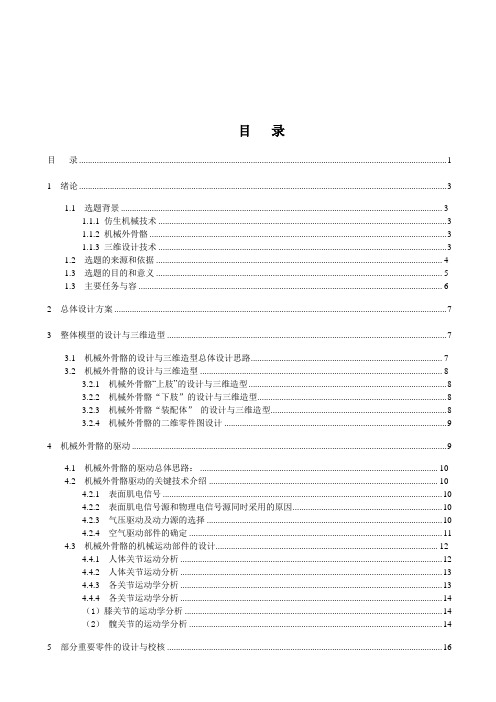
目录目录 (1)1 绪论 (3)1.1 选题背景 (3)1.1.1 仿生机械技术 (3)1.1.2 机械外骨骼 (3)1.1.3 三维设计技术 (3)1.2 选题的来源和依据 (4)1.3 选题的目的和意义 (5)1.3 主要任务与容 (6)2 总体设计方案 (7)3 整体模型的设计与三维造型 (7)3.1 机械外骨骼的设计与三维造型总体设计思路 (7)3.2 机械外骨骼的设计与三维造型 (8)3.2.1 机械外骨骼“上肢”的设计与三维造型 (8)3.2.2 机械外骨骼“下肢”的设计与三维造型 (8)3.2.3 机械外骨骼“装配体”的设计与三维造型 (8)3.2.4 机械外骨骼的二维零件图设计 (9)4 机械外骨骼的驱动 (9)4.1 机械外骨骼的驱动总体思路: (10)4.2 机械外骨骼驱动的关键技术介绍 (10)4.2.1 表面肌电信号 (10)4.2.2 表面肌电信号源和物理电信号源同时采用的原因 (10)4.2.3 气压驱动及动力源的选择 (10)4.2.4 空气驱动部件的确定 (11)4.3 机械外骨骼的机械运动部件的设计 (12)4.4.1 人体关节运动分析 (12)4.4.2 人体关节运动分析 (13)4.4.3 各关节运动学分析 (13)4.4.4 各关节运动学分析 (14)(1)膝关节的运动学分析 (14)(2)髋关节的运动学分析 (14)5 部分重要零件的设计与校核 (16)5.1轴承的选择及校核 (16)5.2连杆的计算与校核 (16)5.3双头螺柱的校核 (17)6 机械外骨骼材料的设计选择 (17)7 做本课题时遇到的问题及解决方法 (17)结论 (18)致 (19)参考文献 (20)附录1: 机械外骨骼的设计与三维几何建模过程图 (21)附录2: 机械的零件图 (33) (50)附录3: 机械外骨骼的渲染效果图 (58)仿生机械的三维设计——机械外骨骼的设计1 绪论1.1 选题背景1.1.1 仿生机械技术模仿生物的形态、结构和控制原理设计制造出的功能更集中、效率更高并具有生物特征的机械。
漫威电影类型化生产的市场优势与艺术模式

2023年第3期(总第332期)㊀㊀㊀㊀㊀㊀学㊀习㊀与㊀探㊀索Study&Exploration㊀㊀㊀㊀㊀㊀㊀㊀㊀No.3ꎬ2023㊀㊀㊀㊀㊀㊀㊀㊀Serial.No.332当代文艺理论与思潮新探索漫威电影类型化生产的市场优势与艺术模式张㊀㊀遥(吉林大学文学院ꎬ长春130012)摘㊀要:经过二十余年的不断发展ꎬ漫威电影宇宙已形成了一套成熟的电影世界观ꎬ成为好莱坞电影一个举足轻重的分支ꎬ在娱乐市场中独占鳌头ꎬ也形成了其在艺术生产方式和文化传播方式上的独特的成功经验ꎮ首先ꎬ漫威电影的类型化生产方式及其所创造的诸多成功的案例ꎬ构成了一个个类型化电影创作和传播的范式ꎬ具有可模仿或复制的艺术价值和商业价值ꎮ其次ꎬ漫威电影宇宙显示出一种典型的集约化㊁类型化和模式化的艺术生产和文化传播的特点ꎮ最后ꎬ漫威电影打造了系统化㊁关联性的人物形象谱系ꎮ这种艺术生产和文化传播策略为中国的影视业发展提供了某种参照ꎬ具有重要的启示意义ꎮ关键词:漫威电影ꎻ类型化生产ꎻ人工智能ꎻ漫威电影宇宙中图分类号:J9㊀㊀文献标志码:A㊀㊀文章编号:1002-462X(2023)03-0168-06基金项目:国家社会科学基金项目 人工智能时代文学叙事和传播方式的技术反思研究 (21BZW50)作者简介:张遥ꎬ吉林大学文学院副教授ꎬ文学博士ꎮ㊀㊀熟悉中国电影市场和喜爱美国漫威电影的观众可以注意到ꎬ间隔了很长一段时间的空档ꎬ今年春节过后ꎬ漫威系列电影作品又重新回到中国影院ꎮ2023年2月7日ꎬ漫威的«黑豹2:瓦坎达万岁»在中国内地上映ꎬ10天之后ꎬ漫威的另一部影片«蚁人与黄蜂女:量子狂潮»也与北美同步在中国内地上映ꎮ2019年的«蜘蛛侠:英雄远征»之后ꎬ漫威电影就没有出现在中国内地观众面前ꎮ时间的间隔导致鉴赏的中断ꎬ而且«黑豹2»在2022年11月就已经在美国上映ꎬ很多中国影迷已经提前在网络上先睹为快ꎬ使内地影院的上映一开始便流失了一部分观众ꎬ造成 «黑豹2»上映首日的票房仅有2001.8万元ꎬ而2月8日的单日票房就较前一日腰斩ꎬ在排片方面ꎬ2月7日的排片占比约19%ꎬ到2月9日ꎬ便下滑到16%ꎬ而到2月16日后ꎬ该片的票房将下滑到5%以下 [1]ꎬ失去了以往漫威电影在中国内地上映时的热度ꎮ这在漫威登陆中国以来是绝无仅有的ꎮ长期以来ꎬ漫威电影在全球市场上独占鳌头ꎬ其艺术生产方式和文化传播方式上的成功经验ꎬ对于我国电影业的发展具有一定的启示意义ꎮ㊀㊀一㊁集约化生产:好莱坞模式的升级版漫威电影的类型化生产方式及其所创造的诸多成功的案例ꎬ构成了一个个类型化电影创作和传播的范式ꎬ具有可模仿或复制的艺术价值和商业价值ꎬ其实这也是好莱坞电影的类型化创作和文化产业模式的延续ꎮ产业化发展的前提是将影视艺术生产作为一种 文化产业 来看待ꎬ发掘其具有一般经济行为的机制及其产生的价值ꎬ这是市场经济对于文化领域渗透和影响的必然结果ꎮ从中国电影产业改革的角度来看ꎬ文化产业的认知是文化生产对于市场化的一种主动反应ꎮ而从文化事业的角度来看ꎬ文化生产的产业化又是对于市场的一种被动的承受ꎮ无论从哪一个角度说ꎬ产业化㊁传播效果和经济效益都越来越成为电影生产必不可缺少的重要内容ꎮ2000年10月ꎬ«中共中央关于制定国民经济和社会发展第十个五年计划的建议»中ꎬ第一次正式使用了 文化产业 这一概念ꎮ2002年11月ꎬ党的十六大报告中进一步将 文化建设和文化体制改革 作为文化事业改革的重点ꎬ而电影业明确被定义为 可经营的文化产业 [2]ꎬ从861而为中国电影业的市场化变革提供了重要的理论和政策的认知前提ꎮ在世界影视业的发展过程中ꎬ美国漫威电影宇宙的产业化路径与经验不仅将好莱坞的文化产业模式推向了一个新的阶段ꎬ而且引起了国际电影业界的高度关注和效仿ꎮ这对于后起的中国影视文化产业来说ꎬ更具有特殊重要的启示意义ꎮ漫威电影宇宙的产业化具有纵向发展和横向构成的多种属性ꎮ从纵向发展来看ꎬ通过对电影生产过程的不断改进和资本运作ꎬ主动和被动地利用版权交易ꎬ使漫威电影业不断发展壮大ꎻ从横向构成来看ꎬ漫威通过漫画㊁动画㊁电影㊁电视㊁游戏㊁玩具及其他衍生品等不同类型产品的共建与共进ꎬ构成了文化产业可能具有的全产业链ꎮ其实ꎬ漫威电影宇宙已经成为一个巨大的工程ꎬ像蜘蛛网一样ꎬ环环相扣循序渐进ꎬ形成了一个有机的整体ꎮ这种有机体最终是向外扩散的ꎬ具有跨越行业和市场的功能ꎮ20世纪后期开始ꎬ好莱坞迪斯尼㊁20世纪福克斯等八大公司都不同程度进行了产业的调整和组合ꎬ进入了一个 巨兽时代 ꎮ漫威影业有限责任公司原本是漫威娱乐公司下的一个电视和电影工作室ꎬ2009年连同漫威动漫被迪士尼收购ꎬ成为华特 迪士尼影业的子公司ꎮ被迪士尼收购不仅是漫威发展的市场行为和重要契机ꎬ更是对艺术创作和产业化发展的重新定位ꎮ作为好莱坞最主要的电影公司ꎬ迪士尼影业从市场运作和艺术风格等方面具有典型的好莱坞特色ꎬ而漫威影业自然被纳入这一文化产业大系统之中ꎬ成为好莱坞电影的新的标志ꎮ许多研究者关注到这种由内向外的产业化模式ꎬ指出漫威电影宇宙在产业化进程中的每一个环节都有不同程度的借鉴意义ꎮ其中ꎬ涂艺在«浅析漫威电影IP产业链的模式创新»中ꎬ把漫威影业作为IP项目开发与盈利的成熟市场中的典型代表ꎬ分析了其电影产业链的模式创新: 这种模式就是以IP为核心ꎬ为电影㊁电视㊁游戏㊁音乐㊁动漫㊁文学㊁周边创意等其他娱乐产品提供创意版权ꎬ各模块之间形成互联ꎬ快速完成原始用户的积累及影响ꎬ最终融合呈现多维度㊁立体式的交互 [3]操作模式ꎮ张冲力的论文« 互联网+ 时代IP电影运营模式探析 以漫威电影模式为例»ꎬ同样探讨漫威电影产业化中的IP经验ꎬ作者将漫威电影IP模式视为 互联网+ 时代的产物ꎬ认为 IP电影体现了当下电影发展的新趋势ꎬ并且借助互联网技术在产业链等方面改变了传统电影的运营模式 ꎮ不同于一般制造业ꎬ文化产业属于一种思想创造物ꎬ具有极强的个人属性和精神属性ꎬ版权问题是其生命线ꎮ 而成功IP的打造需要完善的运营体系ꎬ作为电影界的佼佼者 漫威电影公司无疑是最具有借鉴意义的ꎮ从最初的漫画出版社发展成为如今电影界的巨头ꎬ漫威在IP内容的打造ꎬ影片营销以及产业延伸等方面都形成了自身的发展优势ꎬ对我国IP电影的产业化运作具有重要的启示ꎮ [4]20世纪以来ꎬ西方电影中占主导地位的毫无疑问是好莱坞电影的类型与风格ꎬ无论是艺术特质还是生产机制ꎬ好莱坞电影都成为一种艺术范式和模仿对象ꎬ世界电影在某种程度上已经被区分为好莱坞电影和非好莱坞电影ꎮ一般认为ꎬ好莱坞电影的风格特征就是 戏剧化 ꎬ按照最强烈的戏剧冲突和完整传奇的故事情节㊁类型化的人物形象来设计影片ꎬ也就是所谓的 好看 ꎮ但是ꎬ应该说这是世界上绝大多数电影的模式ꎬ因为电影文学直接传承于戏剧ꎬ戏剧化自然就是传统电影的风格ꎮ而我们认为好莱坞电影对于世界电影最独特和最深刻的影响就是其生产机制和传播机制的成功ꎮ艺术创作的模式化来自于作品之间的连续性模仿所形成的一定的套路ꎮ好莱坞以某种成功的影片为基本模式ꎬ然后借此进行批量化生产ꎬ使之成为一种有效率的生产模式ꎮ这种模式在好莱坞近百年的电影生产历史中日渐完善和趋于系统化ꎬ形成艺术创作㊁文化生产㊁传播㊁消费等一系列经典化机制ꎮ这种商业模式是适合大工业㊁流水线㊁流程化生产的ꎮ它制作的高票房大片ꎬ符合文化产业的市场逻辑和观众需求ꎮ这种商业模式虽然不断被批评家和学界质疑ꎬ也不断被艺术探索片挑战ꎬ但是从艺术大众化立场和文化产业市场化效果来说ꎬ好莱坞这种模式是有一定的研究和961推广价值的ꎮ而漫威电影宇宙将这种模式化的优势发挥到极致ꎬ使其更适合全球化㊁全媒体化的新业态ꎮ进入新世纪ꎬ美国电影在经历了金融危机和 9 11 事件之后ꎬ 美国«时代»周刊以 地狱10年 为本国的 零零年代 做了总结 [5]ꎮ文艺发展往往与社会发展不同步ꎬ 美国的 地狱十年 也是超级英雄电影发展的黄金十年ꎮ这一阶段的超级英雄电影不仅在数量上达到了前所未有的高峰ꎬ并且在电影产业化㊁主题的多元化㊁电影美学的成就各方面都超出了以前任何一个阶段ꎬ并且也成功地体现了全球化的影响力ꎬ成为好莱坞当下电影中最为商业和主流的一种电影类型 [6]ꎮ有美国学者认为在现今的电影产业格局中 超级英雄电影是好莱坞多种题材电影的 救世主 [7]ꎮ好莱坞模式通过漫威电影宇宙的成功ꎬ获得了新的提升和扩大ꎬ其电影风格和产业模式在世界电影市场上形成了垄断性的影响力ꎮ完全原创的故事未必就是成功的条件ꎬ有时候由于被模仿者对于前期广大观众心理基础和市场效应ꎬ模仿的作品再次获得成功往往具有事半功倍的效果ꎮ产品只要适应消费者的需求ꎬ就必然有市场ꎮ电影作为一种大众文化的艺术产品ꎬ票房至上是屡试不爽的根本手段ꎮ借助于这种艺术逻辑与市场规则的优化组合ꎬ好莱坞电影业的艺术生产与资本扩张互为促进ꎬ带来效益与影响力的同步提升ꎮ值得注意的是ꎬ在此之中其文化的价值传播也不可小觑ꎮ漫威电影宇宙不是无源之水㊁无本之木ꎬ而是在好莱坞电影艺术和产业化基础之上建构的一种新模式与新路径ꎮ同样ꎬ它也为好莱坞模式的转变和发展提供了很好的借鉴和启示ꎮ㊀㊀二㊁关联性创作: 电影宇宙 的创造漫威影业的特征和形态有一个颇具共识性的命名:漫威电影宇宙(MarvelCinematicUniverse)ꎬ意指以漫威漫画角色和剧情为基础制作的互为关联的系列电影所构成的艺术世界和文化产品ꎮ整体上看ꎬ漫威电影宇宙显示出一种典型的集约化㊁类型化和模式化的艺术生产和文化传播的特点ꎮ简而言之ꎬ漫威电影宇宙的本质就是通过个体的交互联结形成一个既各自独立又相互映照的整体ꎬ同时也建构了艺术世界和市场效应之间的相关关系ꎮ早期漫威在资金和发行等方面存在较多困难ꎬ虽然通过合资和版权出售等方式度过了危机ꎬ但是也给其艺术生产和知识产权等带来了麻烦ꎮ1944年ꎬ漫威出品了第一部由漫画改编的动画片«美国队长»ꎬ获得成功后ꎬ漫威改编制作了多部类似的超级英雄动画片ꎬ包括著名的«钢铁侠»«蚁人»«雷神»等ꎮ这种以个人角色为主的动画片与漫威的版权现状有关ꎮ由于早期不断出售自己的漫画版权合或资生产ꎬ使各个超级英雄的作品版权分属不同的公司ꎬ所以漫威在2008年以前的影片在人物和情节设置上往往属于一种个人英雄传记的类型ꎬ在同一部影片中各个超级英雄不能同时出现ꎬ只能根据合作公司的不同而变换影片的主角ꎮ但是ꎬ这只是外在的市场方面的原因ꎬ其深层次的原因应该与最初的编导者的艺术构想有关ꎮ同时ꎬ这也是好莱坞英雄影片的传统风格ꎮ为了摆脱经营的困境ꎬ2008年漫威进军电影业ꎬ并以12个动漫超级英雄为抵押ꎬ获得美林证券5.25亿美元贷款ꎬ开始独立拍摄电影ꎮ同年漫威独立拍摄了第一部超级英雄电影«钢铁侠»ꎬ上映之后获得巨大成功ꎬ并奠定了漫威电影宇宙的基本风格:在原有英雄传记的基础上ꎬ增加了各个影片之间人物和情节的联系ꎬ每部影片努力为下一部影片中英雄人物的出场和故事的延续做铺垫ꎮ一系列的英雄电影构成了漫威电影的独特系统和风格ꎬ标志着漫威电影宇宙的基本形成ꎮ 在«钢铁侠2»中ꎬ托尼斯塔克的工作室中ꎬ其父遗留的图纸上出现了美国队长的盾牌ꎬ紧接而后上映的«美国队长»中正是钢铁侠的父亲为美国队长设计的盾牌ꎮ«雷神»中一个教授提及他认识一个朋友是搞伽马射线的ꎬ自从和神盾局搞上关系就失踪了ꎬ此处则暗指绿巨人ꎮ在«复仇者联盟2:奥创纪元»中班纳博士提到了振金的原属地始于 瓦坎达 ꎬ这同之后的«黑豹»情节对应ꎮ这种影片之间的互动叙事ꎬ给观众带来了更大的吸引力ꎬ也激起了观众的好奇心和讨论热度ꎮ托马斯 沙兹说过:071通过包括票房反馈在内的交换循环ꎬ制片厂与观众有着实际上的 对话 ꎮ藉此ꎬ他们逐步地确立了电影表述的 语法 ꎮ [8]电影不只是顺应观众ꎬ还要培养观众ꎮ因此ꎬ如何把握大众热点和思想潮流是检验一个导演思想能力和艺术功底的重要途径ꎮ漫威的超级英雄电影借助传统英雄叙事ꎬ将当下的社会热点问题融入其中ꎬ不仅提升了英雄形象的思想境界ꎬ丰富了故事内容ꎬ也容易唤起观众的现实感和观影兴趣ꎮ例如ꎬ «美国队长»反映了反法西斯战争中美国军队的奋勇顽强ꎻ«恶灵骑士»与美国六七十年代的朋克文化和 骑士 文化紧密相关ꎻ«银河护卫队»伴随着人类六十年代对外太空的探索孕育而生 [9]ꎮ而漫威著名导演安东尼 罗素与乔 罗素兄弟在首次执导«美国队长2»和«美国队长3»时ꎬ把握住了当下人类共同关注的恐怖主义等问题ꎬ将超级英雄与 九头蛇 犯罪组织的斗争做了精彩的展示ꎬ不仅完成了导演风格的转变ꎬ而且实现了票房的突破ꎮ特别是«美国队长3»中那17分钟的机场大战情节被誉为超级英雄史上最精彩的高潮段落ꎬ凸显了各位超级英雄的个人特点和人性化色彩ꎬ并以此奠定了两位导演在漫威的重要位置ꎮ«复仇者联盟3:无限战争»«复仇者联盟4:终局之战»更是通过超强的叙事能力ꎬ将漫威电影英雄故事和人类社会可能遇到的重大问题暗暗连接ꎬ全面铺陈和展开故事ꎬ把漫威电影宇宙故事线索和英雄群体进行整合ꎬ使复杂的叙事线和复杂的人物关系环环相扣ꎬ形成一个完整的叙事链条ꎬ从而为漫威电影宇宙的发展留下了标志性的创意ꎮ伴随着漫威电影在中国内地市场的大热ꎬ漫威电影的产业化机制和艺术生产模式很快引起了我国电影业界和理论批评界的注意ꎬ一些批评家和业界人士对此进行了针对性研究和一定程度的实践ꎮ于昊在« 漫威模式 对中国电影构建 电影宇宙 的启发»中ꎬ通过 漫威电影宇宙 从发端到发展的过程的回顾ꎬ揭示了漫威电影文化现象的本质ꎬ认为 漫威影业所开创的这种产业化发展模式对于中国系列电影的开拓及 电影宇宙 的构建具有积极的借鉴意义ꎮ漫威庞大的漫画资源为电影创作提供了丰富的IP文本ꎬ每部电影之间的叙事连接使得这个宇宙更加紧密ꎮ在空间上ꎬ大到宇宙苍穹ꎬ小至量子世界ꎻ在时间上ꎬ从二战到当下ꎻ变种㊁科技㊁神力 都可以在这个宇宙中找到 [10]ꎮ当然ꎬ产业化并不等于模式化ꎬ模式化是产业化达到成熟甚至过度成熟的标志ꎮ漫威电影宇宙从创意到制作和传播㊁营销都形成了自己独特的体系与风格ꎬ具有明显的模式化特征ꎮ这里要明确指出的是ꎬ 电影宇宙 与系列电影有本质上的不同:系列电影属于一个故事的后续发展ꎬ具体表现形式就是 续集 ꎬ例如 007 系列㊁ 哈利波特 系列㊁ 速度与激情 系列㊁ 狄仁杰 系列等ꎮ这些系列电影的故事内容往往是一个接一个的故事ꎬ故事情节没有交叉ꎬ故事人物也多以一个或几个为主ꎬ并且中心人物不变ꎻ而 电影宇宙 是在同一个体系中包含多个不同维度㊁不同版块㊁不同系列电影的一个庞大的故事空间ꎮ在这个空间里不同系列的电影在内容上相互勾联㊁相互照映ꎬ不同的人物在不同的叙事空间中实现共享ꎬ使之成为既各自独立又互为一体的庞大结构体系ꎮ从电影工业的角度来说ꎬ电影宇宙有自己的运行规律及轨道ꎬ而漫威影业总裁兼首席执行官凯文 费奇就是这个体系的整体把控人ꎮ他负责故事框架设计㊁整体走向和具体布局ꎬ以保证的宇宙的故事庞大㊁交错㊁繁复而有序ꎮ如果将漫威电影宇宙与好莱坞的 哈里波特 系列㊁ 速度与激情 系列㊁ 指环王 系列等进行比较ꎬ就会发现这些电影续集虽说比较丰富㊁系统ꎬ但主要人物和故事主线相对单一ꎬ没有形成漫威这样庞大交错的叙事体系和叙事空间ꎬ这是它们与漫威宇宙的本质区别ꎮ同时ꎬ于昊还以中国的黄飞鸿系列㊁唐人街探案系列等电影为例ꎬ进一步探讨了中国系列电影与 电影宇宙 的差别ꎮ并且指出了中国目前建构电影宇宙在资金㊁市场环境㊁剧本资源等诸多方面与漫威的差距ꎬ认为由于这些差距的存在ꎬ使中国电影宇宙难以真正成型ꎮ漫威系列作品的导演大多具有粉丝型特征ꎬ通过迎合粉丝的观影需要ꎬ通过续集或 宇宙 的设计ꎬ随时调整作品的结构ꎬ以此来吸引观众ꎬ实现制片公司对于高票房的要求ꎮ导演的作用是以171领导者的角色来积极带动粉丝的热情ꎬ最大限度地尊重原创并向粉丝展现导演的个人风格ꎬ从而完美地将纸质文本变为银幕形象ꎬ进而在艺术创作的同时创造一种影迷文化ꎮ 漫威电影宇宙以神话叙事及英雄人物的塑造ꎬ实现了粉丝文化的聚合[11]ꎮ当然ꎬ在他们身上所体现出的牺牲和冒险精神以及舍我其谁的责任意识ꎬ也是漫威赢得受众消费热情的一种思想品格ꎮ经过近二十年的积累和创造ꎬ漫威电影宇宙具有自己的创新和突破ꎬ与传统好莱坞模式不同ꎬ形成了新好莱坞模式或好莱坞模式的升级版ꎮ但是无论是从公司隶属关系还是从产业模式来说ꎬ漫威电影仍处于好莱坞电影的大系统之中ꎬ其类型化和模式化特点仍然与传统好莱坞模式有明显承性接ꎬ这是一种生产方式ꎬ也是一种文化模式ꎮ㊀㊀三㊁互应性人物塑造:英雄谱系的构建模式漫威电影宇宙的构造元素是多方面的ꎬ但是最为突出的无疑是互应性的人物谱系的构造ꎮ第一ꎬ打造系统化㊁关联性的人物形象谱系ꎮ英雄形象是漫威电影宇宙最为吸引观众的核心看点ꎬ在英雄形象的塑造上ꎬ漫威电影体现出相互关联㊁互为主次的系列性的英雄人物塑造模式ꎬ这是它区别于其他类型或系列电影人物塑造的最突出的特点ꎮ漫威动画和电影最初就是以个人英雄形象塑造为主的ꎬ2008年的电影«钢铁侠»之后ꎬ漫威编导者们开始着力打造英雄系列ꎬ这些英雄人物互有关联ꎬ互相穿插在不同的故事之中ꎬ构成了宏大而完整的英雄宇宙体系ꎮ这种形象谱系与系列电影的形象构成有所不同:漫威电影宇宙的英雄人物不仅是相互关联的ꎬ而且在不同的影片中又各自独立ꎬ互为主角ꎻ而系列电影如 哈利波特 速度与激情 等ꎬ其英雄人物主角大多是固定的和连续的ꎮ所以ꎬ漫威电影宇宙塑造和展示的是英雄群体ꎮ第二ꎬ从弱到强的成长模式ꎮ像人生过程一样ꎬ任何伟大的人物都不是从一出生开始就是无敌的天然英雄ꎬ而是要经过一个艰辛而反复的成长过程ꎮ漫威电影宇宙中的英雄人物也都呈现出这样一种或发成长和发展的过程ꎬ从而使人物形象更加丰满和具有亲近感ꎮ在«复仇者联盟3:无限战争»和«复仇者联盟4:终局之战»中ꎬ众英雄合力也未能战胜灭霸ꎬ生活和精神上都遭受彻底打击ꎬ各自散去寻找自己普通的人生ꎮ但是ꎬ最终他们的意志与品格使他们重新振作起来ꎬ利用时间穿梭返回过去ꎬ找寻当初尚未被灭霸收拢的六块宝石ꎬ改变失败的现实ꎮ经过齐心努力奋战牺牲ꎬ终于完成了这个被认为不可能完成的使命ꎮ这种由弱到强的曲折的发展过程ꎬ其实除了众英雄的意志能力之外ꎬ也显示了人类社会一般的夙愿:邪不压正ꎬ好人最终要战胜恶人ꎮ这也是漫威电影宇宙英雄所具有的人性意识和人类意识ꎬ因此得到了世界各国观众的认同和喜爱ꎮ第三ꎬ配置超强的能力和神奇的武器ꎮ漫威电影宇宙的英雄在性情㊁经历等方面有诸多差异ꎬ但是超强的能力和神奇的武器却是他们的标配ꎮ每个人都有不同的超能力和不同的武器法宝ꎬ往往都是人器合一ꎬ威力四射ꎮ这是漫威电影宇宙对于年轻一代观众最具吸引力的描述ꎬ也是漫威电影技术表现最为耀眼之处ꎮ像古希腊神话故事和«西游记»中人物的武器一样ꎬ漫威电影宇宙中的英雄们身上的武器具有神奇的魔力ꎮ在漫威电影宇宙的开山之作«钢铁侠»中ꎬ托尼 史塔克身着高科技战甲ꎬ所以被称为 钢铁侠 ꎮ托尼的战甲在后续的电影中不断升级ꎬ功能越来越强大ꎮ这些战甲赋予了他超人的力量和飞行能力ꎮ在«复仇者联盟3:无限战争»中ꎬ他的Mark50战甲融合纳米技术ꎬ达到一个全新的境界ꎬ强大到可以和 灭霸 对抗几个回合ꎮ最后ꎬ在«复仇者联盟4:终局之战»中ꎬ他勇敢地从绿巨人浩克手中夺下镶满宝石的无限手套ꎬ决然地打出响指ꎬ挽救了世界而牺牲了自己ꎮ在电影«蜘蛛侠»中ꎬ彼得 帕克原是一名普通的甚至有些懦弱的高中生ꎬ因为被一只受过放射性感染的蜘蛛咬伤ꎬ由此变得像蜘蛛一样双手具有极强的黏合力和飞攀力ꎬ随后他自己又制作了蛛网发射器和蜘蛛战衣ꎬ上天入地ꎬ惩治恶人ꎬ救人危于难之时ꎬ所以被称为 蜘蛛侠 ꎮ在«蚁人»中ꎬ汉克 皮姆博士发明了蚁人战服帮助斯科特 朗完成任务ꎬ蚁人战服不仅拥有使自己身体变小的能力ꎬ而271。
小学教育的压力过大,如何缓解?
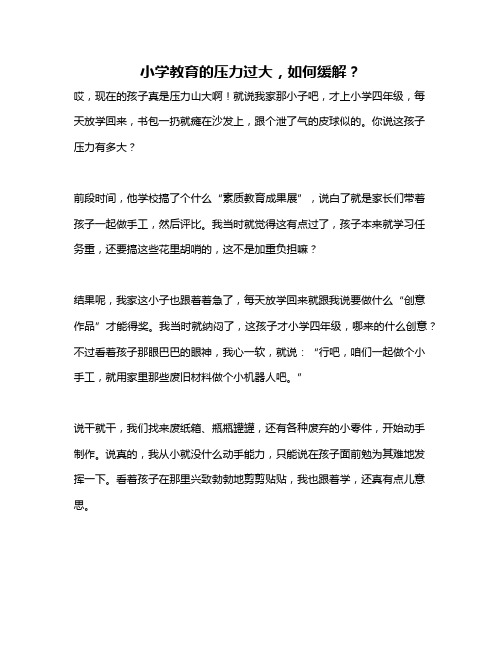
小学教育的压力过大,如何缓解?
哎,现在的孩子真是压力山大啊!就说我家那小子吧,才上小学四年级,每天放学回来,书包一扔就瘫在沙发上,跟个泄了气的皮球似的。
你说这孩子压力有多大?
前段时间,他学校搞了个什么“素质教育成果展”,说白了就是家长们带着孩子一起做手工,然后评比。
我当时就觉得这有点过了,孩子本来就学习任务重,还要搞这些花里胡哨的,这不是加重负担嘛?
结果呢,我家这小子也跟着着急了,每天放学回来就跟我说要做什么“创意作品”才能得奖。
我当时就纳闷了,这孩子才小学四年级,哪来的什么创意?不过看着孩子那眼巴巴的眼神,我心一软,就说:“行吧,咱们一起做个小手工,就用家里那些废旧材料做个小机器人吧。
”
说干就干,我们找来废纸箱、瓶瓶罐罐,还有各种废弃的小零件,开始动手制作。
说真的,我从小就没什么动手能力,只能说在孩子面前勉为其难地发挥一下。
看着孩子在那里兴致勃勃地剪剪贴贴,我也跟着学,还真有点儿意思。
我们一起研究设计图纸,一起涂抹油漆,一起组装零件,整个过程充满欢乐。
虽然最终做出来的机器人看起来有点儿“奇形怪状”,但是孩子却非常开心,还给它取了个名字叫“钢铁侠”。
在这个过程中,我发现孩子并不是真想得什么奖,而是希望得到我的陪伴和认可。
现在想想,学校里的压力固然存在,但只要家长用心陪伴孩子,一起学习、一起玩耍,就能有效地缓解孩子的压力,让孩子感受到学习的快乐,而不是负担。
所以,与其让孩子陷入各种压力,不如多一些陪伴和鼓励,让他们快乐成长,这才是教育的真谛吧! 嗯,说起来,我家那小子最近好像真的轻松了不少,
学习成绩也进步了。
哈哈,看来我这“钢铁侠”还真发挥了作用呢!。
